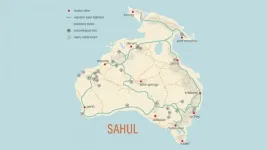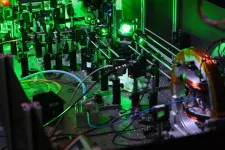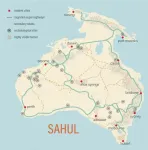(Press-News.org) The best path across the desert is rarely the straightest. For the first human inhabitants of Sahul -- the super-continent that underlies modern Australia and New Guinea -- camping at the next spring, stream, or rock shelter allowed them to thrive for hundreds of generations. Those who successfully traversed the landmarks made their way across the continent, spreading from their landfall in the Northwest across the continent, making their way to all corners of Australia and New Guinea.
By simulating the physiology and decisions of early way-finders, an international team* of archaeologists, geographers, ecologists, and computer scientists has mapped the probable "superhighways" that led to the first peopling of the Australian continent some 50,000-70,000 years ago. Their study, published in Nature Human Behaviour, is the largest reconstruction of a network of human migration paths into a new landscape. It is also the first to apply rigorous computational analysis at the continental scale, testing 125 billion possible pathways.
"We decided it would be really interesting to look at this question of human migration because the ways that we conceptualize a landscape should be relatively steady for a hiker in the 21st century and a person who was way-finding into a new region 70,000 years ago," says archaeologist and computational social scientist Stefani Crabtree, who led the study. Crabtree is a Complexity Fellow at the Santa Fe Institute and Assistant Professor at Utah State University. "If it's a new landscape and we don't have a map, we're going to want to know how to efficiently move throughout a space, where to find water, and where to camp -- and we'll orient ourselves based on high points around the lands."
"One of the really big unanswered questions of prehistory is how Australia was populated in the distant past. Scholars have debated it for at least a hundred and fifty years," says co-author Devin White, an archaeologist and remote sensing scientist at Sandia National Laboratories. "It is the largest and most complex project of its kind that I'd ever been asked to take on."
To re-create the migrations across Sahul, the researchers first needed to simulate the topography of the supercontinent. They "drained" the oceans that now separate mainland Australia from New Guinea and Tasmania. Then, using hydrological and paleo-geographical data, they reconstructed inland lakes, major rivers, promontory rocks, and mountain ranges that would have attracted the gaze of a wandering human.
Next, the researchers programmed in-silico stand-ins for the human travelers. The team adapted an algorithm called "From Everywhere to Everywhere," created by White*, to program the way-finders based on the caloric needs of a 25-year-old female carrying 10 kg of water and tools.
The researchers imbued these individuals with the realistic goal of staying alive, which could be achieved by finding water sources. Like backcountry hikers, the digital travelers were drawn to prominent landmarks like rocks and foothills, and the program exacted a caloric toll for activities such as hiking uphill within the artificial landscape.
When the researchers "landed" the way-finders at two points on the coast of the re-created continent, they began to traverse it, using landmarks to navigate in search of freshwater. The algorithms simulated a staggering 125 billion possible pathways, run on a Sandia supercomputer, and a pattern emerged: the most-frequently traveled routes carved distinct "superhighways" across the continent, forming a notable ring-shaped road around the right portion of Australia; a western road; and roads that transect the continent. A subset of these superhighways map to archaeological sites where early rock art, charcoal, shell, and quartz tools have been found.
"Australia's not only the driest, but it's also the flattest populated continent on Earth," says co-author Sean Ulm, an archaeologist and Distinguished Professor at James Cook University. Ulm is also Deputy Director of the Australian Research Council Centre of Excellence for Australian Biodiversity and Heritage (CABAH), whose researchers contributed to the project. "Our research shows that prominent landscape features and water sources were critical for people to navigate and survive on the continent. In many Aboriginal societies, landscape features are known to have been created by ancestral beings during the Dreaming. Every ridgeline, hill, river, beach and water source is named, storied and inscribed into the very fabric of societies, emphasising the intimate relationship between people and place. The landscape is literally woven into peoples' lives and their histories. It seems that these relationships between people and Country probably date back to the earliest peopling of the continent."
The results suggest that there are fundamental rules humans follow as they move into new landscapes and that the researchers' approach could shed light on other major migrations in human history, such as the first waves of migration out of Africa at least 120,000 years ago.
Future work, Crabtree says, could inform the search for undiscovered archaeological sites, or even apply the techniques to forecast the movements of human migration in the near future, as populations flee drowning coastlines and climate disruptions.
*Co-authors of the study are Stefani Crabtree (Santa Fe Institute, Utah State University, CABAH) who led the project and convened its first working group at the Santa Fe Institute in 2019; Devin White (Sandia National Laboratories) who wrote the primary algorithm used; and members of the Australian Research Council Centre of Excellence for Australian Biodiversity and Heritage (CABAH), who contributed expertise on the Australian landscape and the Aboriginal communities. CABAH members are Crabtree, Sean Ulm (James Cook University), Corey Bradshaw (Flinders University), Frédérick Saltré (Flinders University), Alan Williams (University of New South Wales); Robin Beaman (James Cook University); and Michael Bird (James Cook University), who also co-organized the 2019 working group in Santa Fe.
The Santa Fe Institute is a nonprofit research center located in Santa Fe, New Mexico. Its scientists collaborate across disciplines to understand the complex systems that underlie critical questions for science and humanity. The Institute is supported by philanthropic individuals and foundations, forward-thinking partner companies, and government science agencies.
Sandia National Laboratories is a multimission laboratory operated by National Technology and Engineering Solutions of Sandia LLC, a wholly-owned subsidiary of Honeywell International Inc., for the U.S. Department of Energy's National Nuclear Security Administration. Sandia Labs has major research and development responsibilities in nuclear deterrence, global security, defense, energy technologies and economic competitiveness, with main facilities in Albuquerque, New Mexico, and Livermore, California.
CABAH is an ARC Centre of Excellence that brings together expertise from diverse academic disciplines to answer fundamental questions about the natural and human history of our region, including how and when people first came to Australia.
INFORMATION:
BOSTON - Concerns about fertility often influence how young women with breast cancer approach treatment decisions and are a reason for forgoing or delaying hormone-blocking therapy, a new study by Dana-Farber Cancer Institute investigators shows.
The findings, published online today by the journal Cancer, reinforce the need for physicians to talk with patients about their fertility-related priorities and address them in treatment plans, the study authors write. Such conversations are important not only at the start of treatment but during its entire course, as patients' goals ...
Scientists from the University of Bristol's Quantum Engineering Technology Labs (QETLabs) have developed an algorithm that provides valuable insights into the physics underlying quantum systems - paving the way for significant advances in quantum computation and sensing, and potentially turning a new page in scientific investigation.
In physics, systems of particles and their evolution are described by mathematical models, requiring the successful interplay of theoretical arguments and experimental verification. Even more complex is the description of systems of particles interacting with each other at the quantum mechanical level, which is often done using a Hamiltonian model. The process of formulating Hamiltonian models from observations is made even harder by the nature ...
'Superhighways' used by a population of up to 6.5 million Indigenous Australians to navigate the continent tens of thousands of years ago have been revealed by new research using sophisticated modelling of past people and landscapes.
The new insights into how people not only survived, but thrived, in harsh environments provide further evidence of the capacity and resilience of the ancestors of Indigenous people, and help paint a picture of large, well-organised groups navigating tough terrain.
The 'peopling' of Sahul -- the combined mega continent that joined Australia with New Guinea when ...
There was a hope that as more plants start to grow in Arctic and boreal latitudes as our warming climate makes those regions more hospitable for plants, those photosynthesizing plants would work to help sequester the atmospheric carbon dioxide that helped them flourish in the first place. But new research led by scientists at UC Irvine and Boston University, out in Nature Climate Change, suggests that all the new green biomass is not as large a carbon sink as scientists had hoped.
"What does greening really mean? Can we really trust it to save us from climate change?" said Jon Wang, an Earth system scientist at UCI who the led the work alongside BU Earth & Environment professor Mark Friedl. "A big question is: What'll happen to the carbon that's currently ...
What The Study Did: This survey study examines the associations of school closure and exposure to COVID-19-related stressors with caregivers' perceptions of their children's mental well-being.
Authors: Tali Raviv, Ph.D., of the Ann and Robert H. Lurie Children's Hospital of Chicago, is the corresponding author.
To access the embargoed study: Visit our For The Media website at this link https://media.jamanetwork.com/
(doi:10.1001/jamanetworkopen.2021.11103)
Editor's Note: The article includes conflict of interest disclosures. Please see the article ...
What The Study Did: Using insurance claims data, the change in screening rates for breast, colorectal and prostate cancers during the COVID-19 pandemic were estimated as well as the overall decline in cancer screening last year among the U.S. population.
Authors: Ronald Chen, M.D., M.P.H., of the University of Kansas in Kansas City, is the corresponding author.
To access the embargoed study: Visit our For The Media website at this link https://media.jamanetwork.com/
(doi:10.1001/jamaoncol.2021.0884)
Editor's Note: The article includes conflicts of interest disclosures. Please see the article for additional information, including other authors, author contributions and affiliations, conflict of interest and financial disclosures, and funding and support.
INFORMATION:
Media ...
What The Study Did: This case series investigates the frequency and type of SARS-CoV-2 nasopharyngeal test complications in Helsinki, Finland.
Authors: Anni Koskinen, M.D., Ph.D., of the Helsinki University Hospital in Finland, is the corresponding author.
To access the embargoed study: Visit our For The Media website at this link https://media.jamanetwork.com/
(doi:10.1001/jamaoto.2021.0715)
Editor's Note: Please see the article for additional information, including other authors, author contributions and affiliations, conflict of interest and financial disclosures, and funding and support.
INFORMATION:
Media advisory: The full article is linked to this news release.
Embed this link to provide your readers free access to the full-text article This ...
What The Study Did: Researchers investigated whether spending a year aboard the International Space Station was associated with worsening of spaceflight-associated structural changes to the eye.
Authors: Brandon R. Macias, Ph.D., of the NASA Johnson Space Center in Houston, is the corresponding author.
To access the embargoed study: Visit our For The Media website at this link https://media.jamanetwork.com/
(doi:10.1001/jamaophthalmol.2021.0931)
Editor's Note: The article includes conflicts of interest and funding/support disclosures. Please see the article for additional information, including other authors, author ...
What The Study Did: The association between exposure to antibiotics before birth and during the first year of life and the development of eczema during childhood was evaluated among children in Sweden.
Authors: Mwenya Mubanga, M.D., Ph.D., of the Karolinska Institutet in Stockholm, is the corresponding author.
To access the embargoed study: Visit our For The Media website at this link https://media.jamanetwork.com/
(doi:10.1001/jamanetworkopen.2021.5245)
Editor's Note: The article includes conflicts of interest and funding/support disclosures. Please see the article for additional information, ...
An experimental treatment produced improvements in cognitive function and language in patients with fragile X syndrome, according to study results published on April 29 in Nature Medicine. Fragile X syndrome (known as FXS for short) is the most common known genetic cause of autism and the most common cause of inherited intellectual disability.
"These results offer hope for patients with fragile X syndrome and their families," said Elizabeth Berry-Kravis, MD, PhD, a pediatric neurologist at Rush University Medical Center and principal investigator of the study. "The majority of clinical outcome measures were in favor of the drug. These measures included performance-based ...


